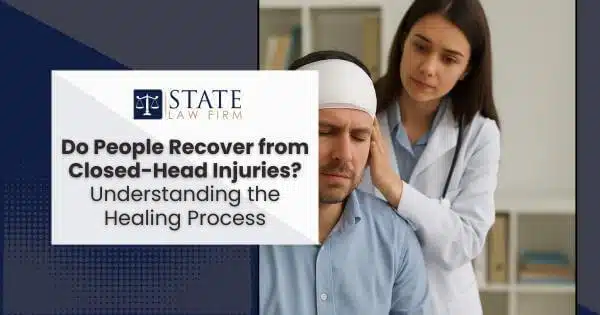Do People Recover from Closed-Head Injuries? Understanding the Healing Process
Closed-head injuries—traumatic impacts that don’t penetrate the skull—are among the most complex and misunderstood injuries people can experience. Whether caused by a car accident, a fall, or another sudden blow, these injuries can disrupt every part of a person’s life in an instant. An estimated 2.8 million Americans sustain a traumatic brain injury (TBI) each year, with many cases involving closed-head trauma and requiring long-term care and support (CDC).
While some individuals recover fully, others face ongoing physical, cognitive, and emotional challenges. At State Law Firm, we’ve stood beside clients and their families as they navigate this uncertain road, helping them secure the resources they need to heal and rebuild their lives.
In this guide, we’ll break down what closed-head injuries are, the immediate and long-term effects they can have, and what the recovery journey often looks like. We’ll also share insights into rehabilitation strategies, key factors that influence outcomes, and where to find additional support. If your injury happened in a collision, you can explore more about your legal options with our Sherman Oaks car accident attorneys. For more information on the lasting impacts, our resource on the long-term effects of traumatic brain injury provides further details.
No two recoveries are the same, but knowledge, preparation, and the proper guidance can make all the difference. Let’s explore what you need to know about closed-head injuries—and what comes next.
What is a Closed-Head Injury?
A closed-head injury occurs when a non-penetrating impact to the skull causes the brain to move within the head. Unlike open-head injuries—where an object breaks through the skull—closed-head injuries often leave no visible wounds, making them harder to detect and diagnose right away.
Common Types of Closed-Head Injuries:
- Concussion: A mild traumatic brain injury (TBI) that can cause temporary loss of consciousness, confusion, and memory problems.
- Contusion: A bruise on the brain caused by impact.
- Diffuse Axonal Injury: Widespread damage to nerve fibers, often resulting from rotational forces.
- Hematoma: Bleeding within the brain that may increase pressure inside the skull.
Even injuries labeled “mild” can have serious consequences over time. If you or someone you love has sustained a head injury, documenting symptoms and seeking prompt medical attention is essential.
Pro Tip: Keep a journal of any headaches, dizziness, mood changes, or memory lapses after an accident. This record can help doctors—and your legal team—understand the progression of the injury.
The Immediate Effects of Closed-Head Injuries on the Brain
Right after a closed-head injury, the brain may respond with swelling, chemical changes, or disruption of neural connections. These effects can cause a wide range of neurological and physical symptoms, including:
- Cognitive Impairment: Trouble focusing, confusion, or disorientation.
- Physical Effects: Headaches, nausea, balance issues, or sensitivity to light and sound.
- Emotional Changes: Irritability, anxiety, or sudden mood swings.
In severe cases, individuals may lose consciousness or experience seizures. Prompt assessment—often involving imaging tests—is critical to rule out life-threatening complications such as brain bleeds.
If your injury happened in a vehicle collision, our Sherman Oaks car accident lawyers can help you understand your rights to compensation for immediate and long-term care.
The Stages of Recovery After a Closed-Head Injury
Recovery looks different for everyone, but it typically progresses through three main stages:
- Acute Phase: Focused on stabilizing the patient and preventing secondary damage.
- Subacute Phase: Rehabilitation begins, targeting motor skills, memory, and daily functioning.
- Chronic Phase: Long-term adjustments, ongoing therapies, and community reintegration.
During each stage, patients may regain abilities at different rates. It’s common to feel frustrated or overwhelmed, especially if progress feels slow. Surrounding yourself with a team that includes healthcare professionals, therapists, and legal advocates can make this process more manageable.
Factors That Influence Recovery from Closed-Head Injuries
Several factors play a role in how—and how well—a person heals:
- Severity of the Injury: More severe trauma often leads to longer recovery timelines.
- Age and Gender: Younger individuals may have a better chance of regaining function, though this varies.
- Pre-Existing Conditions: Previous concussions, neurological issues, or chronic illnesses can complicate healing.
- Support Systems: A strong network of family, friends, and professionals improves emotional resilience and practical recovery.
Pro Tip: Consider working with a case manager or patient advocate who can coordinate care, track medical records, and connect you to resources.
If you’d like to learn about possible long-term impacts, visit our guide on the long-term effects of traumatic brain injuries.
Rehabilitation Strategies and Techniques for Effective Recovery
Rehabilitation is essential for rebuilding skills and confidence after a closed-head injury. Treatment plans are tailored to each person but often include:
- Physical Therapy: Improves coordination, balance, and strength.
- Cognitive Therapy: Focuses on memory, attention, and problem-solving skills.
- Occupational Therapy: Helps patients relearn daily activities and return to work or school.
- Emotional Support: Counseling and support groups address depression, anxiety, and grief.
Recovery can be a long road, but with the right team and approach, many people see significant improvements in quality of life.
At State Law Firm, we understand how overwhelming this journey can feel. If you’re unsure about the next steps or need help exploring compensation for care and rehabilitation, we’re here to guide you through your options with compassion and clarity.


